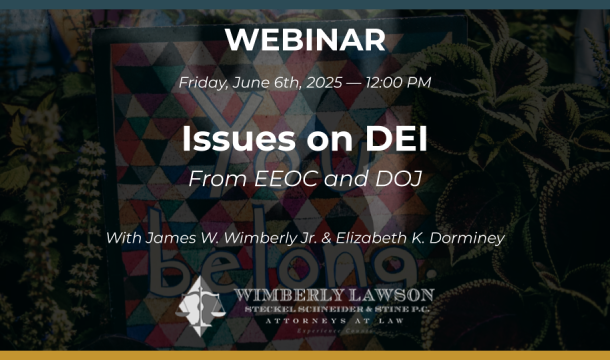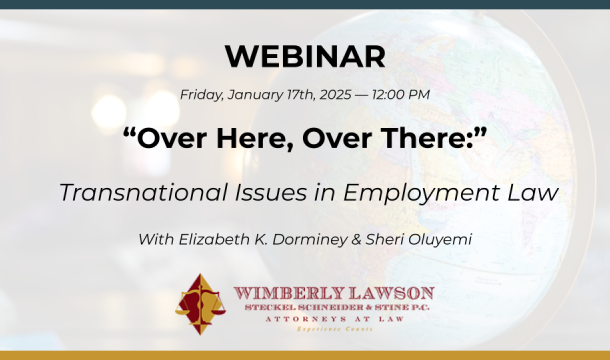Get Ready to Submit Detailed Pay Data to EEOC by September 30
Thanks to a lawsuit, an Obama-era initiative requiring large employers to submit detailed pay data sorted by race and gender has been revived. Employers with more than 100 employees must complete a disclosure form and upload this data for 2017 and 2018, which may be used against them, no later than September 30, 2019.
A website portal has been created to facilitate compliance. On July 15, 2019, the Equal Employment Opportunity Commission (EEOC), in cooperation with the University of Chicago’s National Opinion Research Center (NORC), opened the portal for employers to file their EEO-1 Component 2 wage and hour data.
EEOC has published detailed guidance for employers on how to fill out the form, which requires the collection and disclosure of extensive employment and compensation data. Employees must be sorted into 12 pay bands, which range from about $19,000 to more than $208,000 a year;10 job categories; and then by the same racial, ethnic and sex groupings that were previously used when submitting demographic data in earlier EEO-1 forms.
Employers also are required to submit a report for employee pay data for 2017 by the same September 30th deadline set for when the final installment of the 2018 data is due. Both sets of Component 2 data must include aggregated data for both 2017 and 2018 regarding the pay and hours worked. Employers must draw this data from a single “snapshot” payroll period the employer selects that falls between October 1st and December 31st of each reporting year. Covered employers, including federal contractors, are required to submit Component 2 data if they have 100 or more employees during both of these workforce snapshot periods.
History and Evolution of Component 2
How did this come about? In 2010, the EEOC “joined other federal agencies . . . to identify ways to improve enforcement of federal laws prohibiting pay discrimination.” 81 Fed. Reg. at 5114. Study groups were commissioned and on February 1, 2016, EEOC published a Federal Register notice announcing its intention to seek a three-year approval from the Office of Management and Budget (“OMB”) of “a revised Employer Information Report (EEO-1) data collection.” 81 Fed. Reg. at 5113. The notice explained that the “revised data collection has two components. Component 1 collects the same data that is gathered by the currently approved EEO-1, specifically, data about employees’ ethnicity, race, and sex, by job category. A new requirement, called Component 2, would collect data on employees’ W-2 earnings and hours worked.
Almost one year after OMB had approved the data collection, on August 29, 2017, Neomi Rao, then OIRA Administrator, sent a memorandum to Victoria Lipnic, the Acting Chair of the EEOC, stating that OMB had decided to initiate a review and stay of EEOC’s new collection of pay data under Component 2. The stay was premised on the undue burden that data collection would impose on employers, possibly in violation of the Paperwork Reduction Act. OMB directed EEOC to publish a notice in the Federal Register “announcing the immediate stay of effectiveness of the” pay data collection but “confirming that businesses may use the previously approved EEO-1 form in order to comply with their report obligations for FY 2017.” (EEOC published this notice on September 15, 2017. Stay the Effectiveness of the EEO-1 Pay Data Collection, 82 Fed. Reg. 43362 (Sept. 15, 2017).)
Public interest advocacy groups challenged the stay in a lawsuit. National Women’s Law Center, et al., v. Office of Management and Budget, et al., Civil Action No. 17-cv-2458 (D.D.C.). On March 4, 2019, Judge Tanya Chutkan reversed the stay, and ruled that covered employers had to submit Component 2 EEO-1 W-2 and hours worked data for calendar years 2017 and 2018 by September 30, 2019. The Employer Information EEO-1 report (Standard Form 100) is collected annually under the authority of Title VII of the Civil Rights Act of 1964, 42 U.S.C. 2000e, et. seq., as amended. All employers with 15 or more employees are covered by Title VII and are required to keep employment records as specified by Commission regulations. Based on the number of employees and federal contract activities, certain employers are required to file an EEO-1 report on an annual basis under the Equal Employment Opportunity Commission (EEOC) and the U.S. Department of Labor Office of Federal Contract Compliance Programs (OFCCP) regulations. Judge Chutkan was the same judge who earlier had overturned an attempt by the Trump-era commission to simplify the EEO-1 Form. That change would have removed the enlarged reporting requirements that had been adopted by the Obama-era EEOC and which employers now must meet by September 30.
An appeal was filed May 13, 2019 (No. 19-5130, U.S. Court of Appeals for the D.C. Circuit), though the Trump Department of Justice did not seek a temporary injunction that would have blocked the gathering of Component 2 data while the appeal was being heard. This leaves in place the September 30 deadline for filing the 2017 and 2018 Component 2 reports.
Confidentiality of Submissions
The issue of confidentiality of employer and employee data remains a concern. While Freedom of Information Act (FOIA) exemptions protect privileged and confidential trade secrets and commercial or financial information from disclosure, these exemptions are not likely to protect the Component 2 pay data reports submitted by employers from disclosure. Pay data has long been viewed as sensitive information, so an employer submitting data should try to designate it “business confidential.” The raw data may be used by EEOC or private attorneys to file equal pay lawsuits against employers. Private attorneys could seek the data through a FOIA request or demand the submissions as part of the discovery process.
An employer may limit its exposure to disclosure by asserting that information about compensation is business confidential and cannot be disclosed by an agency without permission. In Chrysler Corp. v. Brown, 441 U.S. 281, 99 S. Ct. 1705 (1979), a government contractor sued to prevent disclosure of information supplied to the Defense Logistics Agency concerning its employment of women and minorities. The Supreme Court held that the Freedom of Information Act afforded no private right of action to enjoin agency disclosure, but that the type of disclosure threatened in that case was not “authorized by law” within the meaning of the Trade Secrets Act through the Office of Federal Contract Compliance Programs (OFCCP) regulations. The Court also held that review of the decision to disclose was available under the Administrative Procedure Act, affording an employer notice of the FOIA request to disclose and an opportunity to oppose disclosure.
Based on this information, a prudent employer will include a “confidentiality statement” with any disclosure, specifying that it considers the information being submitted to be business confidential, and that the agency may not disclose it pursuant to a FOIA request without giving the employer notice and a chance to oppose.
We have included a suggested confidentiality statement and other suggestions to include with the EEO-1 report near the end of this article.
How to Report
Employers must report W-2 Box 1 earnings for the year for all employees identified in the workforce “snapshot” period. This must include a tally of the total number of employees who fall into specific compensation bands by job category, gender, race and ethnicity. If an employee was employed during the workforce snapshot period, his or her W-2 Box 1 earnings must be tallied, even if they are no longer employed at the end of the same year.
Employers must report hours worked, in the aggregate, for all employees in the snapshot period, by gender, race and ethnicity. For nonexempt employees within the meaning of the Fair Labor Standards Act (FLSA), employers should report the annual sum of hours each nonexempt employee worked.
For exempt employees, employers may report either the actual hours worked, or a proxy of 40 hours per week for a full-time exempt employee, and 20 hours per week for a part-time exempt employee, multiplied by the number of weeks the individual was employed during the EEO-1 reporting year.
EEOC requires that employers submit reports via the Component 2 EEO-1 Online Filing System, or as a CSV data file. Companies will receive their User ID from NORC via a notification letter mailed through the U.S. Postal Service and an e-mail sent to the registered EEO-1 e-mail address on record.
Once an employer creates an account, a password will be set up during initial entry into the system, after the employer’s User ID, Federal Employer Identification Number (FEIN), and e-mail address have been verified. Once all reports have been completed for the company, the authorized official must certify that the information reported is accurate and prepared in accordance with the instructions.
After they are submitted, employers will be unable to access their 2017 and 2018 Component 1 reports in the Component 2 EEO-1 online filing system. In addition, data from previously filed 2017 and 2018 EEO-1 reports will not be in the new online application for the reporting of Component 2 data. There will be no pre-population of historical data in the Component 2 EEO-1 online filing system. In other words, once the data is submitted the employer will not be able to see it again, to avoid having to re-invent the wheel, a prudent employer will take care to create and retain backup copies of all documentation.
When to report.
The District Court’s Order states that Component 2 information for 2017 and 2018 must be filed by September 30, 2019, but is that a hard-and-fast deadline? It is not clear whether an employer can request extra time, or delay filing a report, nor is it clear that any liability would arise from a failure to file at all.
Following the EEO-1’s lead, it appears that an employer may request an extension of time to file the report, but this would offer only a brief advantage. Because of the pending appeal, and the potential for changes either from the government or the courts, virtually every commentator agrees that it is best to wait and file at the last minute. Given the lack of any meaningful penalties for tardiness, there is little risk to a late filing.
It’s not clear whether an employer can request an extension. Prior notices allowed an employer to request a 2-week extension by emailing a request to E1.EXTENSIONS@EEOC.GOV. This information was not updated when the deadline was changed to September 30, 2019. It is possible that the government will not allow any extension since that language was omitted from the current terminology. However, it is not expected that the portal will be shut down immediately, so as a practical matter, late filings can be made.
Penalties.
What about not filing at all? Many employers have used the “whoops, my bad” excuse to good effect when advised that their affirmative action reports are past due. There appears to be but a single instance of an employer being fined by EEOC for failing to submit an EEO-1 report: the fine assessed was $100 – not much of a penalty at all.
The situation may be more serious for federal contractors subject to OFCCP, who are at risk of being penalized or even disbarred for failure to comply with regulations. However, OFCCP does not appear to have made enforcement a priority: there appears to be only one case the penalty assessed by OFCCP was significant.
Recent Developments and Suggestions for Completing "Additional Comments" Portion of Component 2.
A comments box has recently been added to the form and our firm suggests several conditions for each filing employer to be put in that location.
1. The information provided is considered by the employer to be private, privileged and confidential, and the information submitted is done so with the assurance that it will not be disclosed.
2. The employer made its best efforts to gather information as required based upon dates set retroactively, therefore the information provided is qualified due to various data-gathering issues.
3. The persons in the various pay rates herein do not perform equal work.
For more information
EEOC has set up a toll-free help desk at NORC for employers. Employers may call 877-324‑6214 or send email to EEOCcompdata@norc.org. Additional information and advice is available from the EEOC at: https://eeoccomp2.norc.org/info. The commission also is offering the answers to employers’ frequently asked questions at: https://eeoccomp2.norc.org/faq.
Sample form: https://eeoccomp2.norc.org/assets/documents/Comp2EEO1OnlineFilingSampleForm.pdf
Instruction booklet:
https://eeoccomp2.norc.org/assets/documents/Comp2EEO1InstructionBook.pdf
Questions? Need more information?
Contact Jim Wimberly (jww@wimlaw.com) or Elizabeth Dorminey (bdorminey@bellsouth.net) or call 404-365-0900.
Related Content
Get Email Updates
Recent Content

The EEOC and DOJ Issue Guidance on DEI

Considerations When Government Officials Show Up and Request to Meet with Individual Employees

How Jurors Evaluate the Fairness of an Employer’s Actions

Some of the Controversial Issues Currently Being Faced by Employers in Light of Recent Developments

Frequently Asked Questions About Recent Immigration-Related Actions



